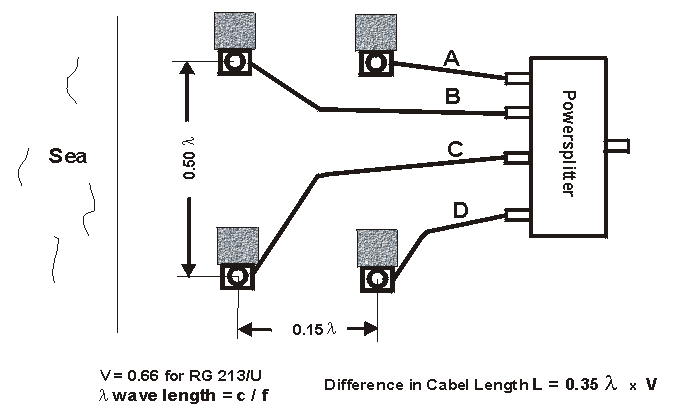|
1. A typical WERA installation
The figure shows an example of a WERA installation. If a linear receive antenna array is used, this should be installed parallel to the coast to minimize the influence of the signal path over land on the receive antenna beam pattern. Receice and transmit antennas should be set-up on a straight line to ensure the null in the transmit antenna pattern to point to the receive antenna. The required minimal distance between transmit and receive antennas is 100 m to ensure sufficient isolation (>70 dB) on the direct path (WERA uses FMCW, i.e. transmitter and receiver are operated simultaneously). The area (angle) covered by the HF radar is ±60° perpendicular to the receive antenna array, if a linear array is used for receiving. In case of the 4-antenna square array (surface currents only, no ocean wave measurements possible), the covered area is given by the transmit antenna pattern. To maximize the working range, the antennas should either be installed as close to the water as possible, or on top of a cliff. |
| Depending on the working frequency used by the
radar, antenna height
and spacing varies. For a working frequency of 27.65 MHz, antenna
spacing
is 5.42 m (half the electromagnetic wavelength) or for a working
frequency of 16.00 MHz the antenna spacing is 9.35m. So the total
length of the whole antenna array becomes around 160 m. The antenna height of a full length quater-wave groundplane is 2.7 m. Below 25 MHz, the antenna must be electrically shortened using a coil or a wound wire to ensure enough mechanical stability to withstand stroms. The transmit antenna consists of two rows of 2-element linear array antennas with 0.5 Lambda spacing. The two rows are 0.15 Lambda apart. To form the antenna pattern, the cables from the power splitter to the antennas have to be cut to a specific length. The cables A and D (to back row) have to be 0.35 Lambda shorter than the cables B and C (to front row). The propagation speed factor for RG213/U is V = 0.66 and has been taken into account for the calculations of the values given in the table below.
The null produced in the antenna pattern should point towards the receive antennas to reduce the energy transmitted on the direct path from the transmit to the receive antenna. The transmit power amplifier, which also houses the power splitter, is located at the transmit antenna. A 200 m long RG 213/U cable is required for the transmit radio signal, a power cable (115/230 V, 3*2.5 mm²) is required for operation of the power amplifier. Here are photos of the transmit antenna installed at Gijon (Spain): 2.2 Receive antenna linear array If sea state is to be measured, e.g. significant waveheight and wave directional spectra, a 16-element linear array is required. A 12-element linear array can also be used, but gives some coarser azimuthal resolution. The total length of 16-element array is 15 * 5.42 m = 81.3 m at 27.65 MHz. The antenna spacing and variances in height of the mounting points should be within 1 % accuracy. We often use wooden sticks of ~5 cm * ~8 cm to fix the antennas to, so fine adjustments can be done during installation. Each antenna is connected to a separate receiver channel, so 16 cables RG 213/U, each 200 m long, adjusted to ±20 cm difference in length, are required.
2.3 Receive antenna square array If only surface currents are to be measured, a small 4-element square array at 5.42 m diagonal spacing (at 27.65 MHz) together with a direction finding technique for azimuthal resolution may be used.
|
The following requirements have to be met to
ensure proper operation of WERA:
4. Power supply and communication requirements
|
